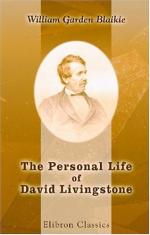The residence of the Livingstones at Chonuane was of short continuance. The want of rain was fatal to agriculture, and about equally fatal to the mission. It was necessary to remove to a neighborhood where water could be obtained. The new locality chosen was on the banks of the river Kolobeng, about forty miles distant from Chonuane. In a letter to the Royal Geographical Society, his early and warm friend and fellow-traveler, Mr. Oswell, thus describes Kolobeng: “The town stands in naked ’deformity on the side of and under a ridge of red ironstone; the mission-house on a little rocky eminence over the river Kolobeng.” Livingstone had pointed out to the chief that the only feasible way of watering the gardens was to select some good never-failing river, make a canal, and irrigate the adjacent lands. The wonderful influence which he had acquired was apparent from the fact that the very morning after he told them of his intention to move to the Kolobeng, the whole tribe was in motion for the “flitting.” Livingstone had to set to work at his old business—building a house—the third which he had reared with his own hands. It was a mere hut—for a permanent house he had to wait a year. The natives, of course, had their huts to rear and their gardens to prepare; but, besides this, Livingstone set them to public works. For irrigating their gardens, a dam had to be dug and a water-course scooped out; sixty-five of the younger men dug the dam, and forty of the older made the water-course. The erection of the school was undertaken by the chief Sechele: “I desire,” he said, “to build a house for God, the defender of my town, and that you be at no expense for it whatever.” Two hundred of his people were employed in this work.
Livingstone had hardly had time to forget his building troubles at Mabotsa and Chonuane, when he began this new enterprise. But he was in much better spirits, much more hopeful than he had been. Writing to Mr. Watt on 13th February, 1848, he says:—
“All our meetings are good compared to those we had at Mabotsa, and some of them admit of no comparison whatever. Ever since we moved, we have been incessantly engaged in manual labor. We have endeavored, as far as possible, to carry on systematic instruction at the same time, but have felt it very hard pressure on our energies.... Our daily labors are in the following sort of order:
“We get up as soon as we can, generally with the sun in summer, then have family worship, breakfast, and school; and as soon as these are over we begin the manual operations needed, sowing, ploughing, smithy work, and every other sort of work by turns as required. My better-half is employed all the morning in culinary or other work; and feeling pretty well tired by dinner-time, we take about two hours’ rest then; but more frequently, without the respite I try to secure for myself, she goes off to hold infant-school, and this, I am happy to say, is very popular with




